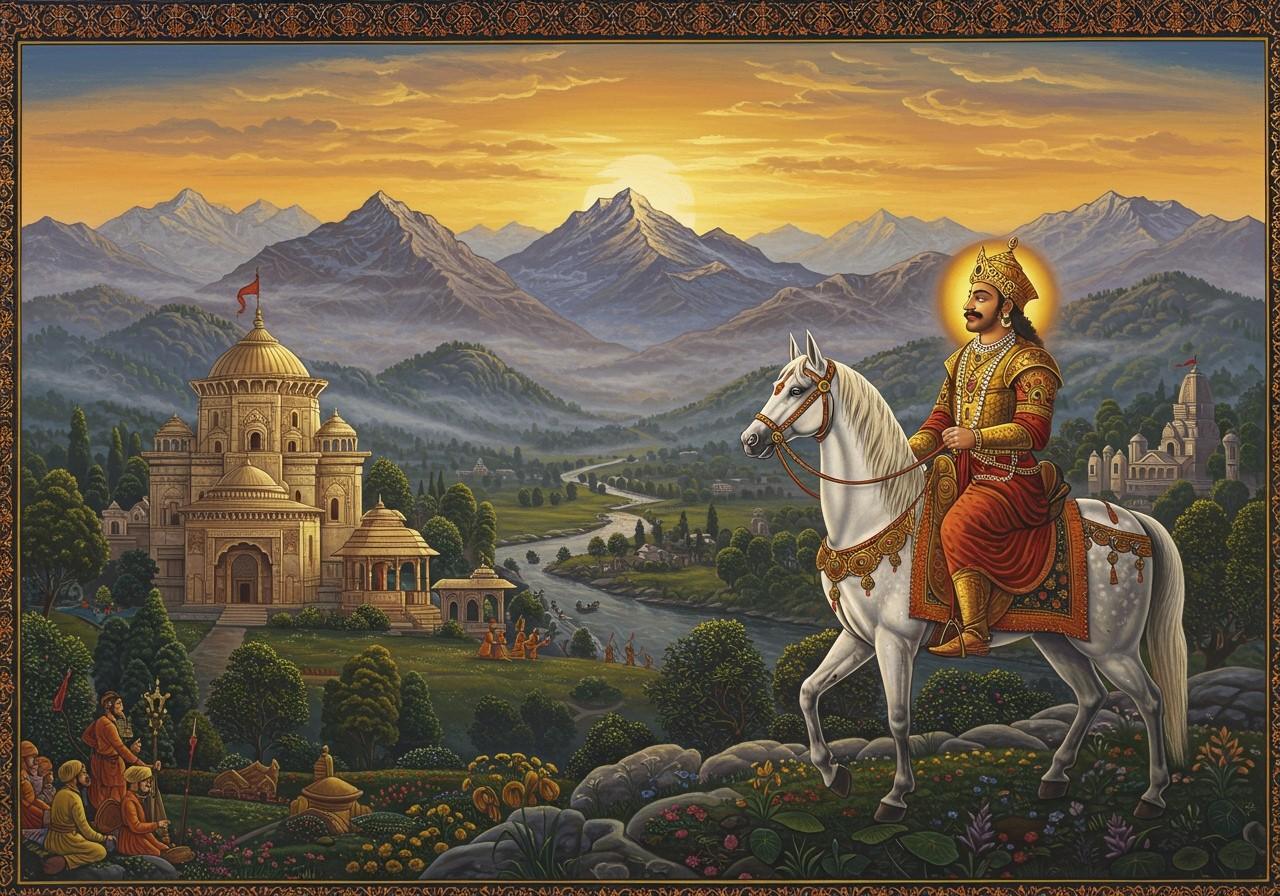
Kashmir’s Golden Age is often linked with the reign of Lalitaditya Muktapida, a powerful Karkota Dynasty ruler (724-760 CE). This era witnessed remarkable cultural and political growth, offering valuable insights into the development of traditions and governance in ancient India. Lalitaditya, often hailed as Kashmir’s greatest king, presided over territorial expansion, cultural exchange, and economic prosperity, as documented by the 12th-century chronicler Kalhana in “Rajatarangini.”
The Rise of the Karkota Dynasty
The Karkota Dynasty emerged in the strategically important region of Kashmir, a central point for trade and cultural exchange. Prior to Lalitaditya’s reign, the area faced instability and external threats. The dynasty’s early rulers laid a strong foundation, paving the way for Lalitaditya’s ascent and subsequent achievements in art, architecture, culture, and learning.
Lalitaditya Muktapida’s Vast Empire
Lalitaditya Muktapida, a prominent figure in the Karkota Dynasty (724-760 CE), significantly expanded his realm, stretching from Central Asia to the Bay of Bengal—encompassing regions like present-day Afghanistan, Pakistan, and parts of North India. This vast empire showcased his exceptional strategic thinking and military prowess. Through shrewd diplomacy and military campaigns, Lalitaditya not only conquered territories but also fostered cultural exchange and unity within his diverse empire, leading to a rich blend of traditions.
Cultural Flourishing During Kashmir’s Golden Age (724-760 CE)
Lalitaditya Muktapida’s reign (724-760 CE) fostered a cultural renaissance in art, literature, and architecture. The Martand Sun Temple stands as a testament to the architectural achievements of this period, reflecting both skilled craftsmanship and religious devotion. Kashmir attracted scholars, artists, and philosophers from around the globe, creating a vibrant intellectual and artistic hub. Lalitaditya’s patronage of the arts further stimulated creativity and innovation.
Economic Prosperity and Trade During Lalitaditya’s Reign (724-760 CE)
Lalitaditya’s rule (724-760 CE) prioritized prosperity. His economic policies established wealth and stability throughout the empire. Kashmir’s strategic position on the Silk Road transformed it into a crucial trade center, facilitating the exchange of goods and ideas. Agricultural advancements and infrastructure development further strengthened the empire’s economy.
Lalitaditya Muktapida’s Enduring Legacy (724-760 CE)
Lalitaditya Muktapida’s legacy of visionary leadership and accomplishments during his reign (724-760 CE) left a lasting impact on Kashmir and the Indian subcontinent. Although the Karkota Dynasty eventually declined due to internal conflicts and external pressures, Lalitaditya’s contributions remain influential. His ability to unify diverse cultures and promote a thriving environment for art, culture, and trade continues to inspire. Lalitaditya is remembered not merely as a conqueror, but as a visionary leader who fostered cultural and economic growth.
Poojn.in: Connecting You to Kashmir’s Royal Heritage
At Poojn.in, India’s largest Dashakarma Bhandar, we provide authentic puja items that honor the rich spiritual traditions of Kashmir’s golden age under Lalitaditya Muktapida (724-760 CE), a period known for grand temples and religious ceremonies. We offer:
- Pure copper and brass items reminiscent of those used in ancient Kashmiri temples, perfect for creating a sacred atmosphere in your home.
- Traditional incense and dhoop sourced from the Kashmir Valley, evoking the fragrances used in ancient rituals.
- Special puja thalis designed for elaborate ceremonies, allowing you to perform traditional Kashmiri pujas with authenticity.
- Sacred items for Surya puja (Sun worship), reflecting Lalitaditya’s devotion to the Sun God, enabling you to connect with this ancient practice.
- Authentic ritual items used in Shaivite traditions prevalent in Kashmir during Lalitaditya’s time, allowing you to experience these historical practices.
Visit www.poojn.in to discover our collection of premium puja samagri. We deliver across India with secure packaging and quality assurance. Contact us at +91 7908548235 for personalized assistance.
Reflecting on Lalitaditya Muktapida’s Timeless Legacy
Lalitaditya Muktapida’s era (724-760 CE) stands as a testament to cultural and economic brilliance in Kashmir’s history. His vast empire and emphasis on cultural unity exemplify effective leadership. His reign showcased a balance of military strength, cultural prosperity, and economic progress. His legacy extends beyond territorial conquests; it embodies a commitment to cultural integration and the flourishing of art, literature, and trade.
FAQs on Lalitaditya Muktapida, the Karkota Dynasty, and Kashmir’s Golden Age
Who was Lalitaditya Muktapida? Lalitaditya Muktapida, a prominent Karkota Dynasty ruler, is renowned for expanding the empire and ushering in a golden age for Kashmir.
What is the Karkota Dynasty? The Karkota Dynasty, a Hindu ruling power in Kashmir from the 7th to 9th centuries, is recognized for its contributions to art, architecture, and cultural development.
What areas did Lalitaditya Muktapida’s Empire cover? His empire spanned a significant portion of northwestern India, including parts of modern-day Kashmir, Punjab, and extending into Central Asia.
How did Lalitaditya Muktapida contribute to Kashmir’s Golden Age? Lalitaditya’s promotion of trade, culture, and religion resulted in prosperity and cultural richness. His reign witnessed advancements in architecture, literature, and the arts.
Is there a map available of Lalitaditya Muktapida’s Empire? Historical maps illustrating his vast empire can be found in various history books and online resources.
What is the significance of Lalitaditya Muktapida in Indian history? His military achievements, administrative skills, and patronage of art and culture mark his reign as a significant period in Indian history.
Where can I learn more about the Karkota Dynasty and Lalitaditya Muktapida? Further information can be found in history books specializing in ancient Indian dynasties, academic journals, and reliable online educational platforms.
Shankaracharya Temple: Architecture, History, and Spirituality
Martand Sun Temple: A Guide to Its History, Architecture, and Importance


